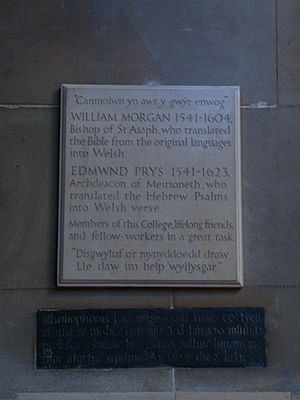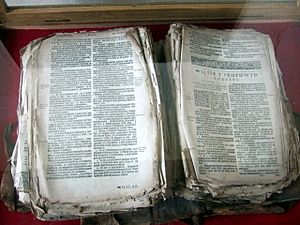Bible translations into Welsh facts for kids
The Bible has been translated into Welsh for a very long time, with some parts appearing as early as the 1400s. For many centuries, the most important Welsh Bible was the one translated by William Morgan in 1588. This version was later updated in 1620. More recently, a new Welsh Bible called Beibl Cymraeg Newydd was published in 1988 and updated in 2004. There's also a modern, easy-to-understand translation called Beibl.net, finished in 2013.
Contents
Early Welsh Bible Translations
First Attempts in the 1400s
Some stories from the 1800s say that a Welsh translation of the Bible existed around 1470. This translation was supposedly made from the Latin Vulgate Bible. One bishop, Richard Davies, even claimed he saw such a translation when he was a boy. However, many experts, like Professor Glanmor Williams, don't believe that the entire Bible was translated into Welsh before William Morgan's famous version in 1588.
William Salesbury's Work in 1567
After the English Reformation, people started translating the Bible directly from the original Greek texts. In 1551, William Salesbury published the first big part of the Bible in Welsh. It was called Kynniver llith a ban and included the Gospels and Epistles, which are parts of the New Testament read in church.
Quick facts for kids Act of Parliament |
|

|
|
| Long title | An Acte for the translating of the Bible and the Dyvine Service into the Welshe Tongue. |
|---|---|
| Citation | 5 Eliz. 1. c. 28 |
In 1563, Queen Elizabeth I passed a law. This law told the Anglican Bishops in Wales to make sure the Bible and the Book of Common Prayer were translated into Welsh. Bishop Richard Davies, Thomas Huet, and William Salesbury worked together on this important task. They translated the New Testament from Greek at the Bishop's palace in Carmarthen. William Salesbury did most of the work.
William Salesbury also translated the Book of Common Prayer from English. It was published on May 6, 1567, along with his translation of the Psalms from Hebrew. The New Testament was released on October 7, 1567. Both were printed in London.
In 1850, a new version of Salesbury's New Testament was printed. It kept the original words but used updated spelling and a modern font to make it easier to read.
William Morgan's Bible of 1588

After Salesbury's New Testament, William Morgan translated the entire Bible into Welsh in 1588. This complete Bible was called Y Beibl cyssegr-lan sef Yr Hen Destament, a'r Newydd. Morgan soon started working on a revised version because his 1588 Bible had some printing mistakes. He updated Salesbury's New Testament and Psalms, and finished the rest of the Old Testament and the Apocrypha.
In 1821, Richard Jones published a new edition of William Morgan's Bible. It was faithful to the original but had updated spelling and a more modern font to make it easier to read.
The Parry Revision of 1620
After William Morgan passed away, Bishop Richard Parry and Dr John Davies continued his work. They wanted to make the language even better and more formal. They also made the Welsh text more similar to the King James Version of the English Bible, which came out in 1611.
The updated version of the Bible was published in 1620. This edition is still known as William Morgan's translation. It became the standard Welsh Bible and was used for hundreds of years, right up until the late 20th century. It is as important to the Welsh language as the King James Version is to English.
The first Bibles were very large and meant for churches. But in 1630, a smaller version called "Y Beibl Bach" (which means "the little bible") was published. This smaller Bible was for people to use at home, making the Welsh Bible available to everyone.
An original copy of the Welsh Bible is on display in St Asaph Cathedral in St Asaph, North Wales. It was even used when Prince Charles became Prince of Wales in 1969.
Translating the Bible into Welsh was incredibly important for the survival of the Welsh language. It helped make Welsh a respected language for worship and everyday communication, even with the strong influence of English.
Today, the William Morgan Bible uses modern spelling. This was updated by Professor Henry Lewis in 1936 for the New Testament and in 1955 for the rest of the Bible. These versions are now available digitally through the Bible Society's "ap Beibl" app.
Welsh Psalms for Singing
Edmund Prys's Singing Psalms, 1621
Salmau Cân (which means "Metrical Psalms") is a translation of the 150 Psalms into Welsh verse. These were made to be sung by people in church. This work was done by Edmund Prys (1544-1623), who was a poet and a church leader. These psalms were first published in London in 1621 with the Book of Common Prayer. Edmund Prys also helped William Morgan with his 1588 Bible translation. Many of these psalms are still sung in Welsh churches today.
Other Metrical Psalms
Over the years, other people also translated psalms into Welsh for singing. Morris Williams created his own Metrical Psalms in 1850. William Rees, a poet, turned William Morgan's Psalms into verse in 1875. In 1936, Rev Lewis Valentine translated a selection of Psalms.
More recently, Salmau Cân Newydd (New Metrical Psalms) was published in 2008. This is a new version of the Psalms by Gwynn ap Gwilym, based on the 2004 Welsh Bible translation and the original Hebrew. It uses different rhythms and suggests tunes for singing.
Modern Welsh Bible Translations
New Welsh Bible, 1988
A completely new translation, called Y Beibl Cymraeg Newydd (BCN), was published in 1988. This included a revised New Testament from 1975 and Psalms from 1979. This new Bible has largely taken the place of William Morgan's older translation. However, the publishers said it was meant to be an alternative, not to completely replace Morgan's work. It also included the Apocrypha.
Revised New Welsh Bible, 2004
A newer version, Y Beibl Cymraeg Newydd Diwygiedig (BCND), which means "the Revised New Welsh Bible," came out in March 2004. The Apocrypha for this version was printed in 2008.
In 2005, an audio version of the BCND was made called "Y Llais" (The Voice). Famous Welsh actors, like Richard Elfyn and Rhys Parry Jones, voiced the parts of Jesus Christ and Paul.
beibl.net, 2015, 2021
beibl.net is a new translation of the Bible into simple, everyday Welsh. The New Testament was first put online in 2002. The entire Bible was available online in 2013 and then in print in 2015. This version was updated again in 2021, and some parts are also available as audio.
New World Translation, 2022
On June 25, 2022, the New World Translation of the Christian Greek Scriptures in Welsh was released digitally by the Jehovah's Witnesses. A printed version followed in December 2022.
Comparing Welsh Bible Translations
| Translation | |
|---|---|
| Testament Newydd William Salesbury, 1567 | Canys velly y carodd Duw y byt, yny rhoddes ef ei vnig-enit vap, y'n y vydei i bop vn a greda ynthaw, na choller, amyn caffael bywyt tragyvythawl. |
| Beibl William Morgan, 1588 | Canys felly y cârodd Duw y bŷd, fel y rhoddodd efe ei uni-genedic fab, fel na choller nêb a'r y fydd yn crêdu ynddo ef, eithr caffael o honaw ef fywyd tragywyddol. |
| Beibl William Morgan, 1620 | Canys felly y carodd Duw y byd fel y rhoddodd efe ei unig-anedig Fab, fel na choller pwy bynnag a gredo ynddo ef, ond caffael ohono fywyd tragwyddol. |
| Y Beibl Cymraeg Newydd, 1988 | Do, carodd Duw y byd gymaint nes iddo roi ei unig Fab, er mwyn i bob un sy'n credu ynddo ef beidio â mynd i ddistryw ond cael bywyd tragwyddol. |
| beibl.net by Arfon Jones, 2008 | Ydy, mae Duw wedi caru’r byd cymaint nes iddo roi ei unig Fab, er mwyn i bwy bynnag sy'n credu ynddo beidio mynd i ddistryw ond cael bywyd tragwyddol. |
See also
- Mary Jones (Bible)
- Y Beibl cyssegr-lan


